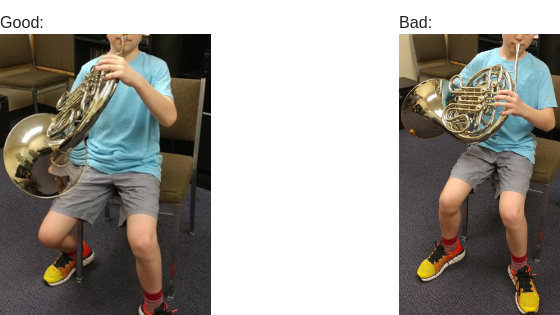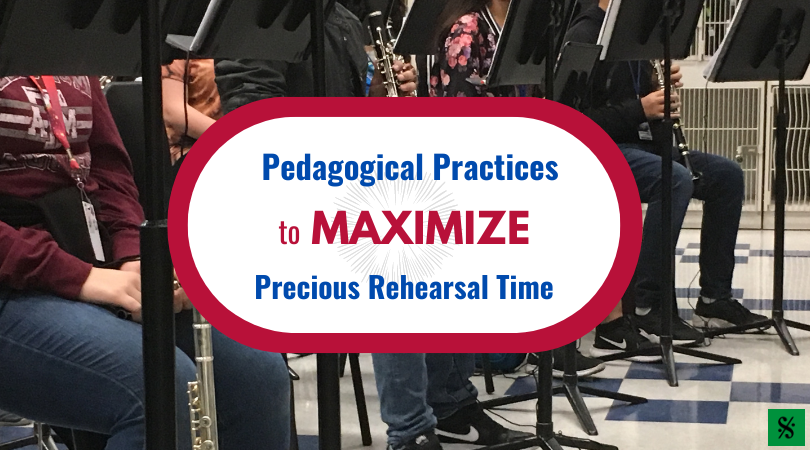There’s no denying it, the horn is an awkward instrument for students that are still physically developing. It’s not that other instruments don’t also have challenges that need to be addressed as the body changes and grows, it’s that the inherent challenges of holding the horn are numerous and not always obvious. As young hornists grow they will need regular attention. Making time for some routine maintenance to your hornist’s posture is valuable.

There are a few “must haves” with good horn posture: an upright torso free of slouching or leaning and a straight neck with the head resting in a natural manner, free of any tilt up-to-down, side-to-side, or a combination of the two. These elements allow the breathing mechanism to work best, minimize tension, and improve tone production. Sitting on the front edge of a chair will make these elements easier to achieve. How do we get the desired results? Here are a few common things to look out for.
Right leg placement
Beginners through middle school (and often times beyond) typically will play exclusively “on the leg.” This is because they don’t have the strength to hold the instrument, because their arms are not long enough to balance the instrument, or, for the grown hornist, because it is the preferred way of holding the instrument. When playing on the leg, the right leg must not be directly in front of the student. Instead, have the student place the heal of their right foot around the front right leg of their chair, angling their foot diagonally to the right. This serves two functions: the bell will face away from the torso of the student allowing their sound to not be muffled by the torso and the leg can adjust up or down to properly angle the horn to the face (more on this to come). Again, sitting on the front of the chair will allow for greatest mobility with the right leg.

Angle of the horn relative to the face
It is worth the music educator’s time to instill the mantra “the horn comes to you” in their students. Perhaps the biggest challenge any developing hornist encounters in regards to posture is taming the horn so that the posture does not suffer. A non-negotiable standard (see below) for the proper torso, neck, and head placement must be set. Without the horn, have the student sit with good posture, right leg as described above, torso erect, head and neck balanced and without tilt. Once set, add the horn and bring the mouthpiece to their lips without allowing the student to adjust their torso, head or neck. In almost every instance the student will either try to adjust their body or, if they do not, the mouthpiece will rest in some place other than directly on the student’s lips. In the miraculous event where the horn fits perfectly to the student’s body, just wait a few months and there will be adjustments that need to be made.

Where the horn naturally rests when the student sits with proper posture is quite valuable information. As people come in all shapes and sizes, a one-size-fits-all mentality is not helpful. However, here are some common challenges and some suggested remedies that maintain the integrity of the posture:
Mouthpiece rests anywhere above the embouchure
The horn needs to be lowered in some way. If the student is able to adjust the height of their right leg to be lower, by moving their right leg back further and having their right foot rest on the toes rather than flat-footed, this is the easiest fix. Along with that, if the bell of the horn can comfortably move closer to the knee as opposed to the middle of the thigh, it will minimize the need for as much bend to the leg. Fine adjustments can then be made by changing the positioning of the left arm and hand to control the angle of the horn.

Mouthpiece rests anywhere below the embouchure
Students with longer torsos may have an issue where when sitting with proper posture the mouthpiece rests near the chin. Adjusting the height of the right leg to be higher by either raising the foot to rest on the toes or by putting a book under the student’s foot, will often help. Moving the horn up the leg further is also possible but is only effective when the angle of the bell remains away from the body.

Right-hand placement
No horn treatise on posture would be complete without mention of right-hand placement inside the bell. Proper placement of the hand inside the bell is for the hand to be slightly angled and along the wall of the bell throat away from the body. The hand impacts projection, accuracy, intonation, and tone color and is an integral part of good horn playing. That said, for a petite beginner, having the hand in this location can actually require excessive stretching and impact the likelihood of good posture in the rest of the body. As a very temporary measure, if a student cannot comfortably place their hand inside the bell as described above, have the student place their hand inside the bell as close to proper positioning as able without stretching.
Once the ideal posture and hand position for a given student is found, have the student practice repeating the process of having the horn at rest and in playing position until they are able to easily go back and forth between the two. Five quick repetitions daily of this will take less than ten seconds and will minimize problems and the need for corrections. No matter the age and size of a hornist, if their body is changing, their posture will need to be re-evaluated. Just because something worked six months ago does not mean it will work again. Pay close attention to your horn players’ posture and create the habit of making small adjustments while maintaining the elements of posture that are needed for success.
Jonas Thoms is Assistant Professor of Horn at West Virginia University. He has performed with the orchestras of Cincinnati, Columbus, Dayton, Ft. Wayne, Louisville, Nashville, Rochester, Syracuse, Toledo, and West Virginia, served on the faculty at the University of Cincinnati College-Conservatory of Music, Wright State University, University of Evansville, and the MasterWorks Festival, presented and performed at International Horn Symposia and regional workshops, and been published in The Horn Call, the International Horn Society’s Journal.
Related Reading:
Helpful Horn Hints (Part 1) – How to String a French Horn Valve
Three Tips for Improving Stopped Horn
Avoiding the Most Common Pitfall – TENSION!
If you would like to receive our weekly newsletter, sign up here.
Don’t forget to like us on Facebook too!
Learn. Share. Inspire.
BandDirectorsTalkShop.com






Leave a Reply
You must be logged in to post a comment.